
| Introduction | Tenant Candidates | Living in Harmony | Exclusion Guidelines |
| Bat Houses | Certification & Application | Professional Excluders | Rehab Contacts |
|
NOTE: For those residing in the United Kingdom, please note that bat exclusion without prior notification to the proper authorities is a punishable offense. The proper authorities to seek guidance from include: English Nature, Scottish Natural Heritage, The Countryside Council for Wales, or the Countryside and Wildlife Branch of the Department of the Environment in Northern Ireland. |
Bats in Buildings: An Information and Exclusion Guide
by
Barbara French, Laura Finn and Mark Kiser
Introduction
 As primary predators of night-flying insects, bats play a vital role in maintaining the balance of nature. A single little brown bat can catch 1,200 mosquito-sized insects in an hour, and big brown bats are important predators of some of America's most costly crop pests. Cucumber beetles, June beetles, bark beetles, stink bugs, leafhoppers, cutworm moths, corn earworm moths, armyworm moths, termites, assassin bugs, ants, roaches, crickets, and grasshoppers
are just some of the many pests known to be consumed by America's bats. Yet, bat populations are in alarming decline due to decades of unwarranted human fear and persecution.
As primary predators of night-flying insects, bats play a vital role in maintaining the balance of nature. A single little brown bat can catch 1,200 mosquito-sized insects in an hour, and big brown bats are important predators of some of America's most costly crop pests. Cucumber beetles, June beetles, bark beetles, stink bugs, leafhoppers, cutworm moths, corn earworm moths, armyworm moths, termites, assassin bugs, ants, roaches, crickets, and grasshoppers
are just some of the many pests known to be consumed by America's bats. Yet, bat populations are in alarming decline due to decades of unwarranted human fear and persecution.
As traditional roosts in trees and caves have been destroyed, many of North America's bats have been forced to seek shelter in man-made structures. An understanding of the habits of these beneficial animals can help solve problems that sometimes develop when bats roost in buildings. The following pages provide details about safe, effective methods for permanently evicting bats from buildings when necessary. These methods help ensure the safety of both humans and bats.
Accidental Intruders
What if you find a bat in your home?
On occasion, a solitary bat may accidently fly into a home, garage or other building through an open door or window. Such incidents often involve lost youngsters whose primary goal is a safe escape. As long as no direct contact with the bat has occurred, it can be released outside. These bats will usually leave on their own if a window or door to the outside is opened while others leading to the rest of the building are closed. Bats are rarely aggressive, even if chased, but may bite if handled. As with any wild animal, bats should not be touched with bare hands, and anyone bitten should immediately seek medical consultation.
If a bat does not leave your home on its own, its exit can be hastened by waiting until it lands, and then covering it with a small box or other container. Slip a piece of cardboard between the wall and box, slide the bat into the box, then release the bat outside. You may also catch it by hand, using leather work gloves to avoid being bitten. Keep doors and windows to buildings closed, and window screens in good repair, to prevent bats from reentering.
Where do bats roost?
Bats may roost in attics, soffits, louvers, chimneys, under siding, eaves, roof tiles or shingles and behind shutters (see diagram). In sports stadiums and parking garages, bats sometimes roost in expansion joints between concrete beams. They can enter through openings as small as one-half inch in diameter (1.3 cm). Common points of entry include open windows or doors, broken or poorly-fitted screens, loose or missing shingles or tiles, places where flashing or boards have come loose and locations where pipes or wiring enter buildings. Openings often occur where walls meet the eaves at the gable ends of an attic, where porches attach to the main part of a house, or where dormers meet the roof. Other points of entry are associated with siding. For example, cracks and crevices are often created where siding forms corners, or at places where it meets windows, doors or chimneys (see diagram). Bats can sometimes be detected by the presence of black or brown stains from body oils or droppings around cracks or crevices formed by ill-fitting building materials. Bat droppings may also appear on walls, under porches or decks, or on floors beneath dilapidated ceilings. Bat droppings are dark and do not contain any white material. Although they may resemble small hard rodent pellets, bat droppings are soft and easily crushed, revealing shiny insect parts.
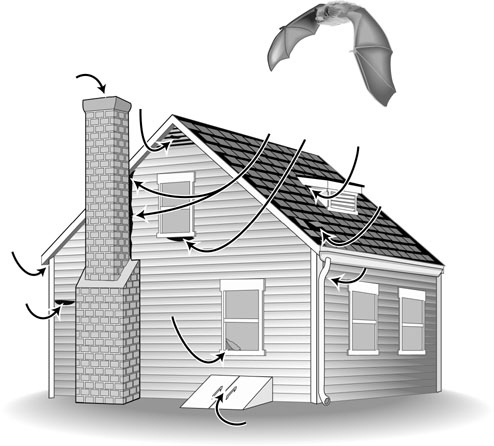
Common entry points on homes and buildings include corners, eaves and louvres.
Providing a safe exit for bats
There is little reason to evict bats from buildings where they are not causing a nuisance. However, bats should be prevented from entering human living quarters. This can be accomplished by inspecting the inside of a building for small openings through which bats could enter. All openings connecting the attic or other roosting areas to inside living quarters should be sealed, although entry points on the outside of the building should be left open, allowing bats to exit. Draft-guards should be placed beneath doors to attics; electrical and plumbing holes should be filled with steel wool, caulking or weatherstripping. Bats have small teeth for eating insects; they do not gnaw through wood or other building materials like rodents. Caulking, flashing, screening or insulation can be used to seal most openings on the inside. Expanding urethane foam products should not be used to seal cracks where bats are active, because they can become caught in it. Caulk should also be applied early in the day so that it has time to dry before bats emerge in the evening.
In some instances, noise or odors from large colonies of bats can become a nuisance. When bats must be evicted from a building, netting or tubes that function as one-way valves must be placed over the openings bats use to enter and exit. These one-way valves allow bats to leave, but not reenter the building. Valves may be constructed from lightweight plastic netting (1/6 inch-0.4 cm-or smaller mesh), or plastic pipes or tubes. These exclusion devices should be left in place for five to seven days to ensure all bats have exited. It is not appropriate simply to wait for bats to fly out at night and then seal openings. Not all of the bats leave at the same time, and some bats may remain inside all night. Take weather conditions into consideration when deciding how long to leave the netting or tubes in place; there may be evenings (such as during storms), when no bats exit.
Bats often roost in buildings seasonally, including during maternity periods, and exclusions should not take place until young bats are able to fly. After the young are old enough to fly, all bats can be excluded. The maternity season begins as early as mid-April in the southernmost U.S., mid-June in the northern U.S. and Canada. Young bats are flying and exclusions can resume by late August. In late fall most house-dwellings bats either migrate to warmer climates or enter caves or abandoned mines to hibernate. However, a few species can hibernate in buildings, and in the mildest climates, they may even remain active year-round. If bats are present in cold regions during the winter, exclusions should be postponed until spring when they emerge to feed.
Exclusion is the ONLY effective solution for permanently removing bats from buildings. Trapping and relocating is ineffective since bats have excellent homing instincts and simply return, even when released at great distances. The use of pesticides against bats is illegal and counterproductive. Poisoning greatly increases the likelihood of bats coming into contact with people and pets.
Naphthalene, the active ingredient in moth balls, and ultrasonic devices are often promoted as bat repellents. However, ultrasonic devices are ineffective against bats, and to be effective, naphthalene must be used in such large quantities that it poses a significant health hazard to humans.
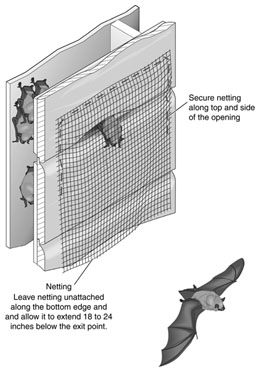 Using Netting to Exclude Bats
Using Netting to Exclude Bats
Bats sometimes enter buildings through openings on smooth surfaces of exterior walls or through louvers. In such cases, plastic or lightweight, flexible netting with 1/6 inch (0.4 cm) mesh or smaller, should be secured to the building along the top and sides of the opening as shown in the diagram. It should extend 18 to 24 inches (46 to 61 cm) below the bottom edge of the opening and should remain in place for a minimum of five to seven days to ensure all bats have exited. Then, openings should be permanently sealed with silicone caulking, caulk backing rod, hardware cloth, or heavy-duty netting. In some cases, sealing may require repair or replacement of old, deteriorated wood. When bats are using multiple openings to exit and enter, exclusion material should be placed on each opening unless it can be determined with certainty that all areas used by the bats are connected. If so, some openings can be sealed as described above, and netting can be placed over the openings used by the most bats. Even when all roosting areas are connected, bats will sometimes refuse to use alternative exits. In this case, exclusion material must be installed over all exits. After this has been done, watch to make sure the bats are able to exit safely. If they do not appear to be exiting, or appear to be having trouble doing so, make adjustments or add new valves as needed.
Using PVC pipe or Empty Caulking Tubes to Exclude Bats
There are a number of situations in which tubes work best as bat exclusion devices. Examples include openings used by bats on buildings constructed from materials that do not create smooth exterior walls, such as those found on brick or stone houses, and log cabins. Tubes also work best for holes located at corners where walls meet and on horizontal surfaces such as soffits. Exclusion tubes should have a 2-inch (5 cm) diameter and be approximately 10 inches (25.4 cm) in length. Exclusion devices can be made from PVC pipe or flexible plastic tubing. According to Laura Finn of Fly by Night, Inc., empty caulking tubes work well for this purpose. When using caulking tubes, both ends must be cut out. Use of a flexible plastic tube makes it easy to either squeeze one end of the tube so that it fits into a crevice, or cut one end of the tube into flaps that can be fit over an opening and stapled, nailed, or taped to the building (see diagram). Bats are unable to cling to the smooth surface of these tubes. Do not let the tube project more than 1/4-inch (6 mm) into the opening, ensuring that bats can easily enter the tube to exit. Caulking tubes must be thoroughly cleaned before use to prevent bats from sticking to wet caulk and because dried caulk creates a roughened surface, making it possible for bats to re-enter. Once the tube has been inserted over the hole, a piece of light weight, clear plastic can be taped around the end of the tube that projects to the outside (see diagram) to further reduce the likelihood of bats reentering, though this is typically not necessary.
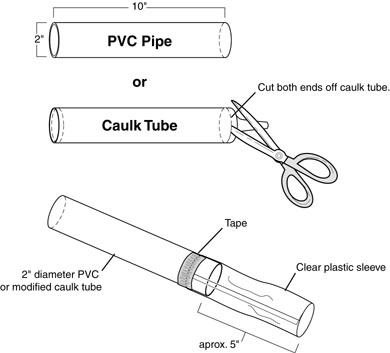
Plastic sleeves collapse on themselves, preventing bats from reentering once they have crawled out through the tube. After the tube has been inserted into or over the opening used by bats, any spaces between the outer rim of the tube and the building must be sealed shut. Be sure also to seal shut any other openings in the building that bats could use to reenter. Leave the tube in place for a minimum of five to seven days to ensure all bats have exited. After the bats have been excluded, the tube should be removed and the opening permanently sealed.
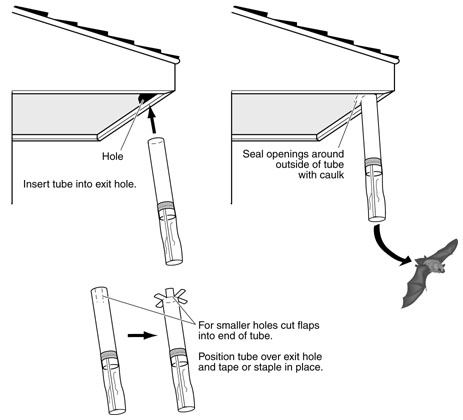
Some concrete parking garages have lengthy crevices used by bats. Multiple exclusion tubes will need to be placed every few feet along the length of each crevice; spaces between the tubes should be closed with heavy-weight (1/6 inch mesh) netting (see diagram). Fold the netting so that it fits into the crevice, and caulk it in place as shown in the diagram. The same procedure can be used in lengthy crevices created where flashing has pulled away from a wall.
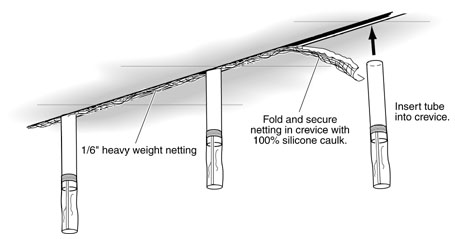
Plastic tubes also work best for excluding bats from under Spanish (clay) or concrete roofing tile. Bats typically enter through open ends of the tiles on the lowest row, or through openings created where tiles overlap one another. Observe the building when bats fly out in the evening to determine which openings they use. Exclusion tubes should be placed in these openings (see diagram). Multiple exclusion tubes are often needed to exclude bats from problem roofs. Collapsible plastic sleeves should also be attached to the ends of the tubes. Heavy weight netting can be folded and inserted into openings where tiles overlap (see diagram).
 Tiles are sometimes temporarily removed to replace a layer of tar paper. When this is done, a layer of coarse fiberglass batting can be put over the tar paper and under the tiles. Constantine (1979) found that the fiberglass layer repelled bats, although he recommended against use of batting within 6 inches (15 cm) of open tile ends to prevent birds from pulling it out for nesting material.
Tiles are sometimes temporarily removed to replace a layer of tar paper. When this is done, a layer of coarse fiberglass batting can be put over the tar paper and under the tiles. Constantine (1979) found that the fiberglass layer repelled bats, although he recommended against use of batting within 6 inches (15 cm) of open tile ends to prevent birds from pulling it out for nesting material.
Bats may also enter a building through spaces beneath corrugated or galvanized roofing sheets. These roofs can be sealed with a variety of materials such as caulk backing rod during months when bats are not present, or after they have been excluded from a building by use of exclusion tubes.
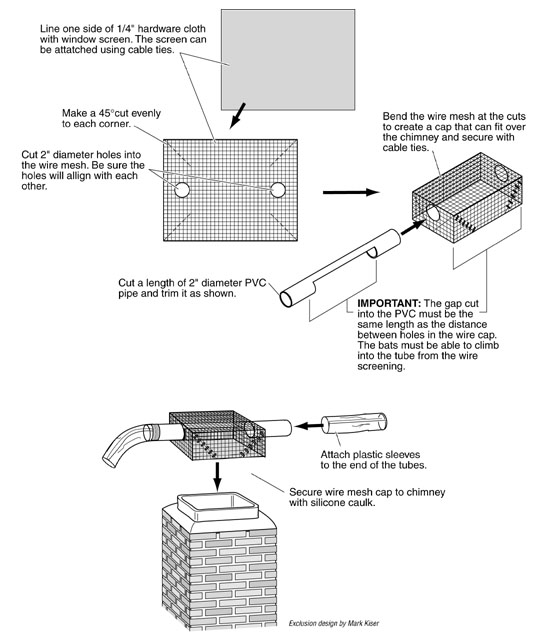
Special modifications may be needed when bats roost in chimneys or in separations between chimneys and roofs. If bats are roosting inside the chimney, construct a wire cage from 1/4-inch hardware cloth lined with window screen. A section of PVC pipe can be cut and then inserted through holes cut into the sides of the wire cage (see diagram). Although bats are able to simply drop down and out of a vertically placed tube that extends below the roost, they are not able to grip the slick surface to crawl out if the tube extends upward above the roost. Therefore, the tubes should project horizontally or down. A collapsible plastic sleeve should be placed over the ends of all exclusion tubes used on chimneys. Once the bats have been excluded, a chimney cap should be installed.
Bats Roosting on Porches at Night
Bats sometimes roost on porches or under overhangs briefly during the night while they digest the insects they have eaten. Non-toxic aerosol dog or cat repellents may be used to discourage bats from roosting in these areas. The spray should be applied by day when bats are not present (Aerosol repellents are not an adequate substitute for exclusion in the case of day roosts and should never be applied when bats are in a roost.) Mylar balloons or strips of aluminum foil hung from the porch ceiling and allowed to move in the breeze may also discourage bats from roosting in that area.
Bat Houses
It's always a good idea to provide bats with a new place to roost. For information on building or purchasing bat houses visit the North American Bat House Project Web site at www.batcon.org/bhra. You can also purchase The Bat House Builder's Handbook or the Building Homes for Bats video through the BCI catalog.
|
NOTE: For those residing in the United Kingdom, please note that bat exclusion without prior notification to the proper authorities is a punishable offense. The proper authorities to seek guidance from include: English Nature, Scottish Natural Heritage, The Countryside Council for Wales, or the Countryside and Wildlife Branch of the Department of the Environment in Northern Ireland. |
| Introduction | Tenant Candidates | Living in Harmony | Exclusion Guidelines |
|
© Bat Conservation International, Inc., 2001. Absolutely no rights of distribution by sale or other transfer of ownership or by rental, lease or lending, preparation of derivative works, or reproduction, in whole or in part, is granted. No text, graphics or photos may be downloaded and used on another Internet site, without express permission of BCI. To obtain permission or further information, send your request to vrc@batcon.org. BCI reserves the rights to actively protect against infringement. Date of last update: 06-05-01 |